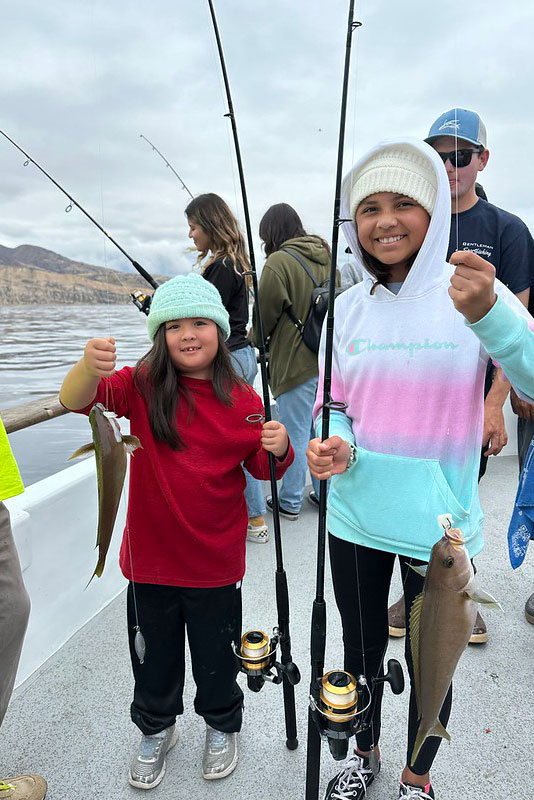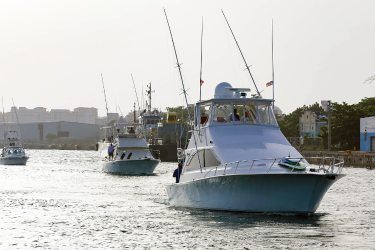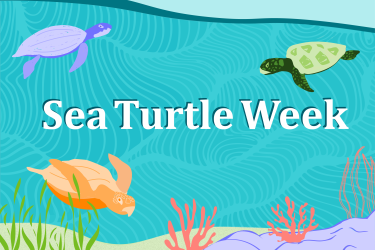As 2023 comes to a close, we want to share a look at some of our work, highlighting national and regional activities that showcase the successes and collaborations shaping NOAA Fisheries’ efforts on recreational fisheries. We remain committed to ensuring a broadly accessible and diverse array of sustainable saltwater recreational and non-commercial fisheries for the benefit and enjoyment of the nation.
National Highlights
In September 2023, NOAA Fisheries released a final revised National Saltwater Recreational Fisheries Policy, along with seven associated regional and national implementation plans. These documents guide our approach to, and work on, saltwater recreational fisheries. "The recreational fishing community is a valued constituency and critical stewardship partner for NOAA Fisheries and the nation," said Janet Coit, Assistant Administrator for NOAA Fisheries. “We are excited to have updated the National Saltwater Recreational Fisheries Policy and new implementation plans that reflect and reinforce our commitment to anglers and sustainable recreational fisheries. We look forward to achieving a vibrant, sustainable future for recreational fishing through partnership.”
Involving anglers in conservation and science was an important focus in 2023. We continued our collaboration with the National Fish Habitat Partnership by supporting four new on-the-ground fish habitat restoration projects actively involving anglers in Florida, Hawaii, and Alaska. The 2023 projects bring our total habitat investments to roughly $1 million in the past 4 years. We also expanded the contributions of anglers to science by supporting a number of research projects that directly involve fishermen in cooperative research. Cooperative research is the partnership between the fishing industry and the science community to improve our understanding of ocean ecosystems and support sustainable fisheries management. These included:
- Fish tagging in the southeast Atlantic and Gulf of Mexico
- Rockfish sampling on the West Coast
- Collecting mahimahi samples in Hawaii
- Establishing a new groundfish sampling program in the northeast Atlantic
Understanding the importance of connecting families and youth to the water, we co-hosted family fishing events in the Florida Keys, Mallows Bay, and Channel Islands National Marine Sanctuaries. These events provided access to the National Marine Sanctuary system and introduced families from underserved communities to recreational fishing and conservation. “We truly enjoy supporting these types of recreational opportunities. Helping to bring families together and introducing kids to a sustainable life-long outdoor activity is incredibly rewarding. We are thrilled to be planning more events like this for 2024.” said Russ Dunn, National Policy Advisor for the Office of Recreational Fisheries.
We also released a Dive In with NOAA Fisheries podcast episode that highlighted the importance of recreational fisheries to the U.S, economy and fisheries habitat. It also discussed the updated National Saltwater Recreational Fisheries Policy. We learned that the recreational fishing community has an appetite for more podcasts and are planning more for the future.
Regional Highlights
Alaska
NOAA Fisheries hosted a series of public scoping meetings in the summer of 2023 to explore the utility of the Recreational Quota Entity. This program collects fees from anglers fishing for halibut from charter boats and will be pooled to purchase additional fishing opportunities for the charter boat fleet. We will continue development of the Recreational Quota Entity program through 2024.
We also signed a 5-year agreement to continue supporting the Bristol Bay Fly Fishing and Guide Academy. This annual training program promotes water, fish, and habitat stewardship, among Alaskan native youth (ages 15–24) and prepares participants for job opportunities in recreational tourism that is reliant on healthy habitats and fish populations. We’re thrilled to continue supporting this program to grow the network of those who understand the value of natural resources and recreational fishing while preparing them for a future career in recreation and stewardship.
West Coast
In 2023, NOAA Fisheries expanded a cooperative recreational sampling program to address research and data needs for groundfish. We trained captains and crews of 18 commercial passenger fishing vessels (also known as headboats) throughout California to measure and record the length of rockfish prior to fileting. After the customers' fish are fileted, the remainder of the fish is processed for biological information. This information contributes to assessments of the health of fish stocks. Partnerships like these in the Greater Atlantic and West Coast regions are helping us collect more data to better understand and inform the sustainable management of the recreational fisheries.
NOAA Fisheries’ partners at the Pacific Coast Recreational Fisheries Information Network completed their updated regional implementation plan for the West Coast. The plan will help guide our allocation of resources to best address the data needs of regional fishery stock assessors and managers. We use these regional plans to develop a national inventory of partner needs and associated costs, and set priorities for supporting these needs.
Greater Atlantic
We implemented the Recreational Harvest Control Rule framework for summer flounder, scup, black sea bass, and bluefish. This framework will improve recreational fisheries management by addressing climate change, increasing emphasis on stock status, and providing greater stability of recreational measures. It was developed in collaboration with the Mid-Atlantic Fishery Management Council and the Atlantic States Marine Fisheries Commission.
We also launched a cooperative research program in New England to collaboratively sample cod with New England charter boats. This partnership will assist with recreational fisheries data collection and cod sampling started in December. As outlined above, this model has been very successful on the West Coast. It uses recreational fishing boats and anglers to help us fill data gaps in the assessment of important recreational species. We hope to continue this collaborative data collection approach across the country to bring more anglers into the science and management process.
Southeast
Conservation of fish and protected species is a priority for anglers and NOAA Fisheries. That is why NOAA Fisheries funded distribution of fish descending devices in partnership with the Caribbean Fishery Management Council to minimize barotrauma in fish caught in deep waters. Barotrauma is a build up of gasses in a fish’s body that makes it difficult or impossible for them to swim back down. The best way to ensure a fish suffering from barotrauma survives is to release it as quickly as possible at depth using descender devices, release weights, or release baskets. Using the NOAA-funded devices, the Council is preparing a public campaign to train charter boat captains about the use of descending devices in the U.S. Caribbean.
To better connect with anglers and protect endangered species, we funded the purchase of sawfish conservation signs in Spanish and English. They will be placed at boat ramps and shore-based fishing access points. These signs and information will continue to raise awareness of this endangered species and the possible interactions with the recreational fishery.
We look forward to continuing to support efforts like these to promote sustainable recreational fisheries and public access. These are two of the guiding principles of the National Saltwater Recreational Fisheries Policy.
Pacific Islands
NOAA Fisheries collaborated with small-boat and kayak anglers to collect mahimahi stomachs to better understand diet habits and changes associated with a changing climate. More than 65 anglers donated more than 300 stomachs and scientists have identified more than 1,500 prey items. Preliminary results reveal that a majority of the prey items found in mahimahi stomachs are juvenile stages of reef-associated animals, such as goatfish and surgeonfish. These results highlight the importance of coral reef larvae as a food source for offshore fish species.
We also conducted bottomfish management data workshops in Guam and Hawaii in 2023. Hongguang Ma, an ecosystems modeler with NOAA, helped to organize these workshops. He said, "These opportunities for public engagement in the fishery management process are essential to building strong, trusting relationships with local communities." During the workshops local fishing communities discussed and provided input on the bottomfish fishing survey data. The Pacific Islands Fisheries Science Center shared stock assessment processes and evaluation of the stock assessment data to build a shared understanding of and support for these scientific approaches.
Atlantic Highly Migratory Species
In 2023, NOAA Fisheries increased equity of access for anglers to the trophy bluefin tuna fishery by splitting the regional trophy area into two areas with equal catch quotas. Prior to 2023, the regional catch quota was often reached before the bluefin tuna reached the summer feeding grounds in the Gulf of Maine. This left anglers in the area little opportunity to target trophy-sized fish. This year, we implemented bluefin tuna regulations that split the Trophy North area into two separate areas, Southern New England and the Gulf of Maine. Each area has equal 2.3 metric ton catch sub-quotas.
In 2023, we also completed the fourth, and final, year of pilot testing a redesigned dockside Large Pelagics Survey. This is the primary data collection for the Atlantic highly migratory species recreational fishery. This survey collects catch and effort information from private and for-hire recreational vessels targeting tuna, sharks, billfish, swordfish, and other large pelagic or highly migratory species from Maine through Virginia. When anglers participate in recreational fishing surveys, they’re making a vital contribution to our understanding of recreational catch. We hope that redesigning the survey will lead to even more complete and accurate information from the offshore recreational fishing community that informs international stock assessments. It also helps ensure managers receive the landings information they need to monitor catch against quotas and pass only those regulations necessary for the long-term sustainability of stocks.







